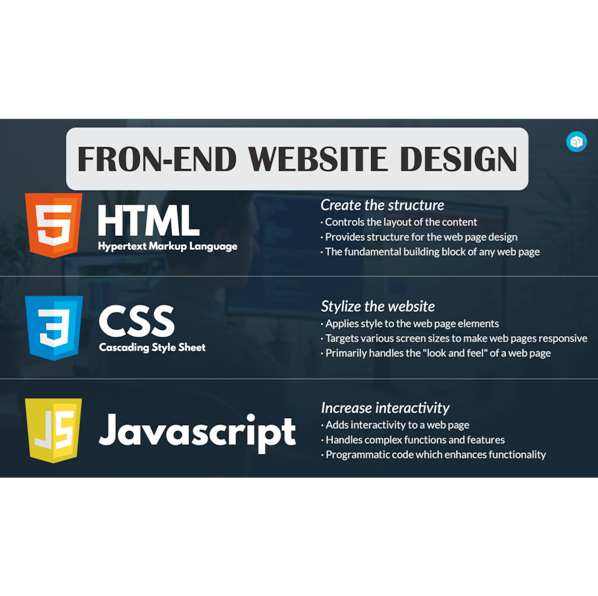JS is available in these courses

JS
JAVASCRIPT.
-
JAVASCRIPT
JavaScript is a scripting or programming language that allows you to implement complex features on web pages. Every time a web page does more than just sit there and display static information for you to look at — displaying timely content updates, interactive maps, animated 2D/3D graphics, scrolling video jukeboxes, etc. It is the third layer of the layer cake of standard web technologies, two of which (HTML and CSS) we have covered in much more detail in other parts of the Learning Area.
Interpreted versus compiled code
You might hear the terms interpreted and compiled in the context of programming. In interpreted languages, the code is run from top to bottom and the result of running the code is immediately returned. You don't have to transform the code into a different form before the browser runs it. The code is received in its programmer-friendly text form and processed directly from that.
Compiled languages on the other hand are transformed (compiled) into another form before they are run by the computer. For example, C/C++ are compiled into machine code that is then run by the computer. The program is executed from a binary format, which was generated from the original program source code.
JavaScript is a lightweight interpreted programming language. The web browser receives the JavaScript code in its original text form and runs the script from that. From a technical standpoint, most modern JavaScript interpreters actually use a technique called just-in-time compiling to improve performance; the JavaScript source code gets compiled into a faster, binary format while the script is being used, so that it can be run as quickly as possible. However, JavaScript is still considered an interpreted language, since the compilation is handled at run time, rather than ahead of time.
There are advantages to both types of language, but we won't discuss them right now.
Server-side versus client-side code
You might also hear the terms server-side and client-side code, especially in the context of web development. Client-side code is code that is run on the user's computer — when a web page is viewed, the page's client-side code is downloaded, then run and displayed by the browser.
Server-side code on the other hand is run on the server, then its results are downloaded and displayed in the browser. Examples of popular server-side web languages include PHP, Python, Ruby, ASP.NET and... JavaScript! JavaScript can also be used as a server-side language, for example in the popular Node.js environment
Dynamic versus static code
The word dynamic is used to describe both client-side JavaScript, and server-side languages . It refers to the ability to update the display of a web page/app to show different things in different circumstances, generating new content as required. Server-side code dynamically generates new content on the server, e.g. pulling data from a database, whereas client-side JavaScript dynamically generates new content inside the browser on the client, e.g. creating a new HTML table, filling it with data requested from the server, then displaying the table in a web page shown to the user. The meaning is slightly different in the two contexts, but related, and both approaches (server-side and client-side) usually work together.
A web page with no dynamically updating content is referred to as static — it just shows the same content all the time.
.


 Basic Fron-End Design
Basic Fron-End Design  Full Stack Web Development Mern Stack
Full Stack Web Development Mern Stack  Mobile App Development
Mobile App Development  Full Stack Web Development Lamp Stack
Full Stack Web Development Lamp Stack